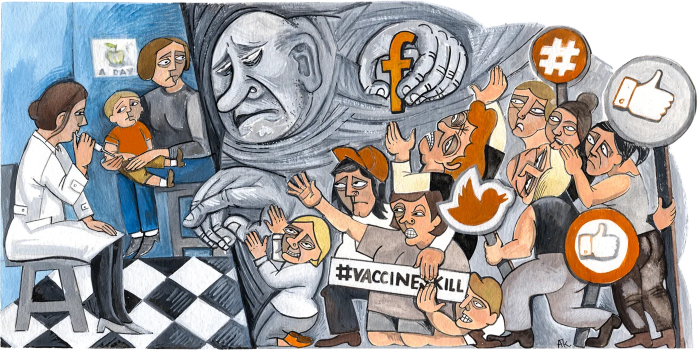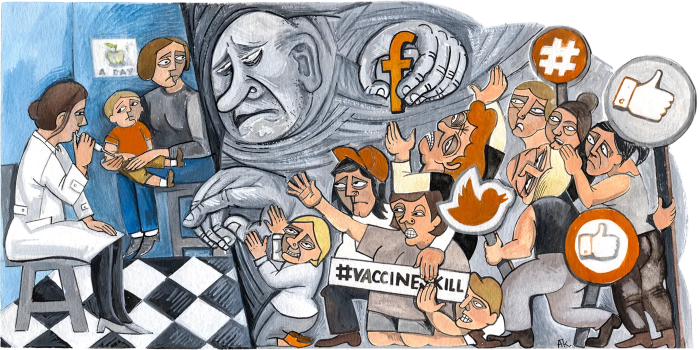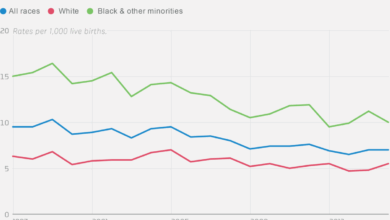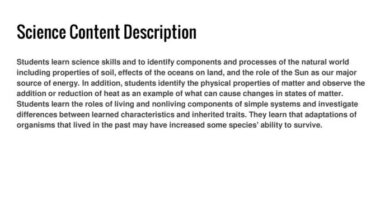
Anti vaccination movement history reveals a troubling pattern of societal anxieties and misinformation, leading to preventable health crises. From early concerns about inoculation to the modern internet age, this movement has consistently challenged public health initiatives, impacting vaccination rates and potentially fueling outbreaks of preventable diseases. This exploration delves into the historical roots of this movement, examining its evolution, the scientific and medical counterarguments, social and cultural influences, political and legal aspects, and illustrative case studies, ultimately assessing its long-term impact and future implications.
The movement’s evolution from early resistance to modern-day social media campaigns highlights the enduring struggle to combat misinformation and build public trust in proven public health measures.
Early Roots of Anti-Vaccination Sentiment
The history of vaccination is intertwined with the history of resistance to it. Long before the scientific understanding of immunology was developed, societal anxieties and distrust of medical interventions played a significant role in shaping attitudes towards vaccination. These early anxieties often stemmed from a lack of understanding about disease transmission and the perceived risks of novel procedures.Early vaccination practices, often relying on empirical observations rather than rigorous scientific methodology, contributed to the perception of inherent risk.
Public acceptance of these practices varied greatly, reflecting the complex interplay of social, cultural, and economic factors. This resistance was not simply irrational; it was grounded in real concerns and anxieties that often stemmed from a lack of clear communication and a dearth of reliable information.
Early Societal Anxieties and Concerns
Public acceptance of vaccination was not uniform throughout history. Before the 20th century, a lack of understanding of disease transmission and the complex mechanisms of immunity led to fear and suspicion. The procedures themselves, often involving incisions and the transfer of bodily fluids, were perceived as risky and unnatural. Religious beliefs, cultural practices, and economic hardship also contributed to resistance.
The perceived lack of benefits relative to perceived risks played a crucial role in shaping attitudes towards vaccination.
Emergence of Early Anti-Vaccination Groups
As vaccination practices gained traction, individuals and groups who opposed them began to organize. Motivations varied, but often included concerns about the safety and efficacy of the procedures, perceived government overreach, and mistrust of medical authorities. These early anti-vaccination movements were often small and localized, but their voices contributed to the growing discourse surrounding vaccination. The lack of robust scientific evidence and clear communication contributed to this skepticism.
Role of Influential Figures and Publications
Several influential figures and publications played a role in shaping public opinion towards vaccination. These figures and publications often articulated concerns about the safety and efficacy of vaccination, sometimes based on flawed or misinterpreted information. The absence of rigorous scientific standards and transparency in medical practices fueled these anxieties. Often, the lack of reliable sources and the spread of misinformation played a crucial role in this early period.
Prominent Controversies and Debates
Debates surrounding vaccination in the pre-20th century were often characterized by a lack of consensus and conflicting viewpoints. These debates were often fueled by the limited understanding of disease transmission and the perceived risks of vaccination procedures. The absence of rigorous scientific studies and standardized protocols created a climate of uncertainty. Different interpretations of observed outcomes and anecdotal evidence further complicated the issue.
The anti-vaccination movement’s history is surprisingly long, with roots stretching back centuries. Understanding how misinformation spreads is key, and that’s where the concept of “diffusion models” comes in handy. Diffusion models, like definition of diffusion models , help explain how ideas, including those promoting distrust in vaccines, spread through populations. This knowledge is critical to understanding the ongoing challenges of countering false narratives about vaccines.
Table: Key Events in the History of Anti-Vaccination Sentiment
| Date | Event | Location | Key Figures/Groups | Summary of the Event |
|---|---|---|---|---|
| 1796 | First Vaccination | England | Edward Jenner | Jenner’s successful vaccination against smallpox marked a significant medical advancement but also sparked immediate controversy. |
| 1800s | Rise of Anti-Vaccination Movements | Various European Countries | Local groups, individuals | Growing resistance to mandatory vaccination emerged as concerns about safety, efficacy, and religious beliefs intensified. |
| 1850s | Anti-Vaccination Pamphlets | United States | Anonymous authors | Anti-vaccination pamphlets began circulating, articulating concerns about government intrusion and individual liberties. |
| Late 1800s | Vaccination Debates in Journals | United States, Europe | Medical professionals, public figures | Discussions in medical journals and public forums reflected the ongoing debate about vaccination’s role in public health. |
The Rise of the Modern Anti-Vaccination Movement
The anti-vaccination movement, far from being a recent phenomenon, has deep roots in history. While early opposition was often rooted in religious or philosophical beliefs, the 20th and 21st centuries witnessed a resurgence, fueled by evolving social, political, and technological factors. This new wave of opposition presented unique challenges, relying on different strategies and arguments than those used in the past.
Understanding these developments is crucial for evaluating the current state of the debate and for addressing public health concerns.The resurgence of anti-vaccination sentiment in recent decades is a complex issue with multiple contributing factors. Concerns about vaccine safety, fueled by misinformation and the perceived overreach of public health authorities, played a significant role. The rise of the internet and social media platforms created new avenues for the rapid dissemination of misinformation, further amplifying anxieties and doubts about vaccination.
Factors Contributing to the Resurgence
The modern anti-vaccination movement benefited from a potent combination of factors. The ease of sharing information online, the rise of distrust in institutions, and the accessibility of pseudoscientific literature all contributed to the spread of misinformation. A culture of individualistic decision-making, coupled with a perception of governmental overreach in public health recommendations, created fertile ground for resistance.
Role of Media and Communication Technologies
The internet and social media have profoundly impacted the anti-vaccination movement. Online forums, blogs, and social media platforms provide spaces for anti-vaccine activists to connect, share information, and build a sense of community. This digital ecosystem allows for rapid dissemination of misinformation, often without fact-checking or verification. Viral videos, articles, and memes contribute to the spread of conspiracy theories and distorted scientific data.
The speed and reach of online communication have significantly magnified the impact of these messages.
Prominent Historical Examples of Anti-Vaccination Campaigns
Numerous campaigns have been launched to oppose vaccination throughout history. The anti-vaccination movement has historically used various tactics. Some campaigns relied on the creation of scare tactics, fear-mongering about the potential side effects of vaccines, and the portrayal of public health authorities as overzealous. Others focused on exploiting the perceived risks of vaccines while minimizing the dangers of preventable diseases.
Comparison of Arguments Across Time Periods
Arguments used by anti-vaccination advocates have evolved over time. Early arguments often centered on religious or philosophical objections to medical interventions. Later, concerns about vaccine safety, based on perceived risks and alleged conspiracies, became central. While the underlying concerns may differ, the fundamental goal of undermining public trust in vaccines has remained consistent.
Table: Evolution of Anti-Vaccination Arguments
| Time Period | Key Argument | Supporting Evidence | Impact |
|---|---|---|---|
| Early 20th Century | Concerns about the safety of new and rapidly developed vaccines | Limited scientific understanding of long-term effects. | Localized, sporadic resistance to specific vaccines. |
| Late 20th – Early 21st Century | Association of vaccines with autism and other health issues. | Debunked studies like the fraudulent Andrew Wakefield paper. | Significant resurgence of anti-vaccination sentiment and decline in vaccination rates in some areas. |
| Present Day | Distrust of government and pharmaceutical companies, conspiracy theories, and emphasis on individual choice. | Spread of misinformation online. | Continued erosion of public trust in vaccines, and outbreaks of preventable diseases. |
Scientific and Medical Counterarguments: Anti Vaccination Movement History

The anti-vaccination movement, fueled by misinformation and fear, has persistently challenged the overwhelming scientific consensus on the safety and efficacy of vaccines. Countering these claims requires a robust presentation of the scientific evidence supporting vaccination. This involves addressing historical anxieties, highlighting the consistent safety record of vaccines, and emphasizing the profound public health impact of vaccination programs.Scientific understanding of infectious diseases and their prevention has evolved considerably over time.
As medical knowledge progressed, so too did the understanding of how vaccines work, leading to refined strategies and increased safety. This evolution has been crucial in mitigating the spread of preventable diseases and saving countless lives.
Historical Scientific Responses to Anti-Vaccination Claims
Early counterarguments to anti-vaccination claims often relied on observational data and anecdotal evidence. The development of germ theory and the subsequent understanding of infectious disease mechanisms provided a more rigorous scientific basis for vaccine efficacy. Public health officials and physicians played a vital role in disseminating accurate information, and early scientific publications helped build a foundation of evidence for the benefits of vaccination.
For instance, meticulous record-keeping of disease outbreaks and their correlation with vaccination rates demonstrated the effectiveness of vaccination programs.
Prominent Medical Figures and Organizations Advocating for Vaccination
Numerous medical professionals and organizations have consistently championed vaccination throughout history. These figures include prominent physicians, epidemiologists, and public health advocates who actively disseminated scientific evidence and promoted vaccination programs. Their efforts have significantly contributed to the widespread adoption of vaccination and its role in preventing infectious diseases. For example, Dr. Edward Jenner’s pioneering work on smallpox vaccination laid the groundwork for modern vaccine development.
Evolution of Vaccination Safety Research and Data
Vaccination safety research has undergone a significant evolution, moving from observational studies to rigorous randomized controlled trials. The inclusion of larger sample sizes, sophisticated statistical methods, and long-term follow-up periods have significantly enhanced the robustness of safety data. These advancements have provided a more reliable basis for evaluating the risks and benefits of vaccination, contributing to the continued public health success of vaccination programs.
Modern research methodologies, coupled with advanced technologies, are continually refining our understanding of vaccine safety.
Impact of Scientific Evidence on Public Health Policy and Vaccination Rates
The accumulation of scientific evidence has significantly influenced public health policy decisions. Governments and health organizations have adopted vaccination recommendations based on the latest scientific findings, leading to the development of vaccination schedules and public health campaigns. The observed correlation between increased vaccination rates and decreased incidence of vaccine-preventable diseases underscores the critical role of scientific evidence in shaping public health policies.
Furthermore, strong scientific evidence has helped to dispel myths and misconceptions surrounding vaccines.
Table of Diseases, Vaccinations, and Efficacy Data
This table provides a snapshot of various diseases, their corresponding vaccines, and the efficacy data associated with those vaccines. Efficacy data often comes from rigorous clinical trials and observational studies, demonstrating the effectiveness of vaccination in preventing and controlling disease transmission.
| Disease | Vaccine | Efficacy (approximate range) | Time Period |
|---|---|---|---|
| Smallpox | Smallpox Vaccine | 95-100% | Late 18th – 20th century |
| Polio | Polio Vaccine (IPV, OPV) | 90-99% | Mid 20th – Present |
| Measles | Measles Vaccine | 95-98% | Mid 20th – Present |
| Rubella | Rubella Vaccine | 95-99% | Mid 20th – Present |
| Mumps | Mumps Vaccine | 95-98% | Mid 20th – Present |
| Hepatitis B | Hepatitis B Vaccine | 90-95% | Mid 20th – Present |
| Influenza | Influenza Vaccine | 40-60% (varies by strain and age group) | Mid 20th – Present |
Note: Efficacy figures are approximate and can vary based on factors such as the specific vaccine formulation, the population receiving the vaccine, and the strain of the virus.
Social and Cultural Factors
The anti-vaccination movement is not simply a scientific or medical debate; it’s deeply intertwined with societal anxieties and cultural trends. Understanding the social and cultural underpinnings is crucial to comprehending the persistence and spread of these beliefs. Factors ranging from distrust in authority figures to a fear of perceived government overreach play significant roles in shaping attitudes toward vaccination.Beyond the realm of scientific evidence, societal influences have shaped and continue to shape public perception of vaccination.
A complex interplay of cultural norms, social networks, and political ideologies contribute to the varying levels of acceptance and resistance to vaccination protocols.
Cultural and Social Trends Influencing Anti-Vaccination Attitudes
Several cultural and social trends have contributed to the rise of anti-vaccination sentiment. A growing distrust in established institutions, including scientific and medical organizations, has created fertile ground for skepticism about vaccination recommendations. This distrust is often coupled with a desire for greater personal autonomy and a resistance to perceived government mandates. Furthermore, a focus on individual freedoms and rights can sometimes lead to a dismissal of collective health concerns.
The anti-vaccination movement’s history is surprisingly complex, tracing back to the 1800s with early anxieties about forced inoculation. Recent debates, however, have taken a more politicized turn, and figures like those in a recent interview with Rep. Jake Auchincloss, rep jake auchincloss interview democrats , highlight the current struggles to address these issues. This highlights how the movement’s evolution is deeply intertwined with broader societal shifts and political landscapes.
The emphasis on natural remedies and alternative medicine has also resonated with some individuals, leading them to question the need for vaccines.
Role of Social Networks and Online Platforms in Spreading Anti-Vaccination Information
The internet and social media have become powerful tools for disseminating misinformation and conspiracy theories related to vaccines. Online communities, forums, and social media groups often facilitate the rapid spread of anti-vaccination narratives. These platforms create echo chambers where individuals are primarily exposed to information reinforcing their pre-existing beliefs, hindering the dissemination of accurate scientific information. The anonymity and ease of sharing information online can also embolden individuals to share unverified or false claims.
This creates a feedback loop that amplifies distrust and reinforces the anti-vaccination message.
Impact of Fear and Misinformation on Public Health Decisions
Fear and misinformation play a crucial role in influencing public health decisions related to vaccination. Concerns about potential adverse reactions, often amplified and distorted online, can lead to vaccine hesitancy or refusal. Misinformation regarding the safety and efficacy of vaccines, disseminated through social media and other channels, can erode public trust in the scientific community. The lack of accurate and readily available information on vaccine safety and effectiveness can exacerbate these fears, contributing to an environment where unfounded concerns outweigh evidence-based knowledge.
Relationship Between Anti-Vaccination Beliefs and Other Social or Political Ideologies
Anti-vaccination beliefs are sometimes intertwined with specific social and political ideologies. These beliefs often align with skepticism towards government intervention, mistrust of authority figures, and a preference for individual autonomy. The correlation between anti-vaccination sentiments and specific political or social groups can vary, highlighting the multifaceted nature of this issue.
Table: Social Factors and Correlation with Anti-Vaccination Sentiment
| Social Factor | Correlation with Anti-Vaccination Sentiment |
|---|---|
| Distrust of Authority Figures | High correlation; individuals distrusting established institutions are more likely to question vaccination recommendations. |
| Emphasis on Individual Freedoms | Positive correlation; emphasis on individual choice can lead to resistance towards mandatory vaccination policies. |
| Focus on Alternative Medicine | Positive correlation; reliance on natural remedies and alternative therapies may lead to questioning the need for vaccines. |
| Social Media Influence | High correlation; online platforms facilitate the rapid spread of misinformation, reinforcing existing anti-vaccination beliefs. |
| Fear and Misinformation | High correlation; concerns about potential adverse effects and false claims can contribute to vaccine hesitancy or refusal. |
| Political Ideologies | Variable correlation; anti-vaccination sentiment may align with certain political ideologies, but not uniformly across all groups. |
Political and Legal Aspects

Governments worldwide have played a significant role in shaping vaccination attitudes and practices. Policies related to mandatory vaccination, funding for vaccination programs, and public health campaigns have often been influenced by political considerations and public opinion. The interplay between public health concerns, individual liberties, and political agendas has led to complex and evolving legal landscapes surrounding vaccination.The influence of government policies on vaccination rates is undeniable.
Mandatory vaccination programs, coupled with robust public health campaigns, can significantly increase vaccination rates within a population. Conversely, resistance to mandatory vaccination policies can result in lower rates, particularly when coupled with misinformation campaigns. These policies often reflect a delicate balance between protecting public health and respecting individual freedoms.
Government Policies and Regulations
Government policies concerning vaccination have historically evolved, adapting to changing scientific understanding, public health needs, and political climates. Early policies focused primarily on controlling infectious diseases, with limited consideration for individual rights. Modern policies often attempt to balance the need for public health protection with the right to bodily autonomy. Regulations regarding vaccine safety, efficacy, and administration have become increasingly stringent over time.
Legal Challenges and Court Cases
Legal challenges to vaccination mandates have emerged as a significant aspect of the anti-vaccination movement. These challenges often center on the perceived infringement of individual rights, the right to bodily autonomy, and concerns regarding potential vaccine side effects. Notable court cases have explored the balance between public health interests and individual liberties, shaping the legal landscape surrounding vaccination.
Evolution of Public Health Policies
Public health policies regarding vaccination have evolved substantially over time. Initial policies focused primarily on mandatory vaccination for specific diseases, such as smallpox. Later, policies expanded to cover a wider range of diseases and emphasized the importance of herd immunity. More recently, there’s a greater emphasis on vaccine hesitancy and the role of public education in addressing it.
The policies also increasingly consider the ethical and philosophical dimensions of vaccination.
Government Responses to Anti-Vaccination Campaigns
Governments have employed diverse strategies in response to anti-vaccination campaigns. These strategies range from public health campaigns emphasizing the benefits of vaccination to stricter regulations concerning vaccine misinformation. The effectiveness of these responses varies depending on factors such as the strength of the campaign, the public’s receptiveness, and the resources available to the government.
Tracing the history of the anti-vaccination movement reveals a surprisingly complex tapestry of anxieties and misinformation. While some early concerns were legitimate, modern iterations often rely on questionable data and echo chambers, much like the way some social media platforms spread false narratives. Interestingly, this parallels the discussion around company culture and leadership changes, as seen in an exit interview with Mastercard’s chief people officer , highlighting the challenges of navigating difficult conversations and maintaining trust in leadership.
Ultimately, understanding the roots of the anti-vaccination movement is crucial for fostering informed public health decisions.
Table: Government Responses to Anti-Vaccination Campaigns
| Country | Policy | Year | Impact |
|---|---|---|---|
| United States | Increased funding for public health campaigns emphasizing the benefits of vaccination. | 2010s | Mixed results, with some success in increasing vaccination rates but continued challenges in areas with high rates of vaccine hesitancy. |
| France | Strengthening regulations regarding the spread of vaccine misinformation online. | 2020s | Reduced spread of misinformation, but concerns about censorship and freedom of speech persist. |
| Australia | Strengthening mandatory vaccination policies for children attending schools. | 2010s | Increased vaccination rates, but also faced legal challenges and public backlash. |
| Canada | Public health campaigns emphasizing the importance of vaccination for COVID-19. | 2020 | High vaccination rates in the early stages of the pandemic, but challenges persist with continued vaccine hesitancy. |
Illustrative Case Studies
The history of anti-vaccination movements is punctuated by specific controversies that have shaped public health outcomes and ignited passionate debates. Examining these case studies provides crucial insights into the dynamics of vaccine hesitancy, the spread of misinformation, and the complex interplay of scientific, social, and political factors. These instances reveal patterns in the arguments used, the strategies employed by proponents of the movement, and the ultimately impactful responses.These case studies highlight the real-world consequences of anti-vaccination sentiment.
They underscore the importance of robust public health infrastructure, accurate scientific communication, and the need for critical evaluation of information sources.
The British Measles Epidemic of 1998
The 1998 publication of a now-retracted study linking MMR (measles, mumps, and rubella) vaccine to autism ignited a global anti-vaccine movement. Andrew Wakefield’s study, later exposed as fraudulent, fuelled widespread concerns and anxieties. This led to a significant drop in MMR vaccination rates in the UK and other countries, resulting in outbreaks of measles and other preventable diseases.
The long-term impact of this episode continues to be felt today. The scientific community and public health agencies responded decisively, publicly refuting the claims and advocating for continued vaccination.
The Anti-Vaccination Movement in the United States and the COVID-19 Pandemic
The COVID-19 pandemic presented a unique challenge for public health. The emergence of misinformation and conspiracy theories surrounding vaccines fueled a surge in anti-vaccine sentiment in the United States. This sentiment was exacerbated by a complex interplay of factors, including social media, political polarization, and distrust in institutions. The impact on vaccination rates was substantial, with a segment of the population remaining hesitant or resistant to vaccination.
Proponents of the movement used arguments ranging from the safety concerns of the rapid development of COVID-19 vaccines to unsubstantiated theories about the virus’s origins and its alleged links to 5G technology. The controversy surrounding the COVID-19 vaccines illustrated the critical role of accurate scientific communication, transparent public health messaging, and the need to address underlying concerns and anxieties to counter the spread of misinformation.
The Anti-Vaccination Movement in France and the Polio Outbreak
In the 1950s and 1960s, France experienced a significant anti-vaccination movement, particularly concerning polio vaccines. The arguments against the polio vaccine centered around concerns about the safety and efficacy of the new technology. This resulted in a significant decrease in vaccination rates, leading to a resurgence of polio cases and highlighting the risks of low vaccination coverage. This case study shows the historical link between low vaccination rates and disease outbreaks, underscoring the importance of maintaining high vaccination coverage to prevent the resurgence of preventable diseases.
Chronological List of Major Anti-Vaccination Incidents
| Incident | Location | Date | Outcome |
|---|---|---|---|
| Wakefield’s MMR study | UK | 1998 | Retraction of the study, increased measles cases, reduced vaccination rates |
| COVID-19 Vaccine Hesitancy | US | 2020-Present | Substantial decrease in vaccination rates, numerous outbreaks of COVID-19, increased mortality and morbidity |
| French Anti-Polio Vaccine Movement | France | 1950s-1960s | Resurgence of polio cases, highlighting the risks of low vaccination coverage |
Long-Term Impact and Future Implications
The anti-vaccination movement has had a profound and lasting impact on public health, extending far beyond the immediate consequences of preventable disease outbreaks. The erosion of trust in scientific consensus and medical professionals, fueled by misinformation and conspiracy theories, has created a legacy of skepticism and hesitancy towards vaccines. This legacy is particularly concerning as it potentially threatens future public health initiatives.The long-term consequences of this movement extend beyond individual choices, impacting entire communities and potentially jeopardizing global health efforts.
The continued spread of misinformation and distrust can hinder the implementation of vital vaccination programs, leading to outbreaks of previously controlled diseases and placing vulnerable populations at risk. Addressing this complex issue requires a multi-faceted approach that targets both the dissemination of misinformation and the rebuilding of public trust.
Lasting Consequences on Public Health
The anti-vaccination movement has demonstrably weakened public health infrastructure. Reduced vaccination rates lead to the resurgence of diseases that had been previously controlled. Measles outbreaks, for example, are increasingly linked to communities with low vaccination coverage, highlighting the direct correlation between anti-vaccination sentiment and disease resurgence. This underscores the critical role vaccination plays in maintaining herd immunity and protecting vulnerable populations.
This reduced immunity can lead to the resurgence of previously eradicated or controlled diseases, potentially creating significant health crises.
Potential Future Implications on Global Health
The anti-vaccination movement poses a significant threat to global health initiatives. The spread of misinformation through social media and other digital platforms has amplified the reach of anti-vaccine rhetoric, making it difficult to counteract. Global health efforts, such as eradicating polio or controlling the spread of infectious diseases, are jeopardized by the rise of vaccine hesitancy. The spread of misinformation across borders and cultures can further exacerbate this issue, requiring a coordinated international response to combat the spread of anti-vaccination narratives.
Failure to address this issue could lead to the resurgence of diseases once considered eradicated, potentially impacting global travel, trade, and economic stability.
Strategies for Combating Anti-Vaccination Narratives
Combating anti-vaccination narratives requires a multifaceted approach. Increased media literacy programs, emphasizing critical thinking skills, can empower individuals to discern credible information from misinformation. Collaboration between public health officials, educators, and medical professionals is crucial to counter misinformation with accurate and accessible information. Open dialogue and transparent communication regarding vaccination safety and efficacy can help build public trust and dispel unfounded fears.
Furthermore, public health campaigns should target specific demographics and address concerns and misconceptions in culturally sensitive ways. The use of trusted community leaders, particularly in marginalized communities, can effectively bridge the gap between public health initiatives and the public.
Correlation Between Anti-Vaccination Movements and Outbreaks of Preventable Diseases, Anti vaccination movement history
| Disease | Year(s) of Outbreak | Estimated Cases | Correlation with Anti-Vaccination Movements |
|---|---|---|---|
| Measles | 2018-2022 | >100,000 cases in multiple countries | Increased cases correlated with declining vaccination rates in several regions, linked to anti-vaccine campaigns and misinformation. |
| Pertussis (Whooping Cough) | 2010-2019 | Significant increase in several regions | Reduced vaccination rates contributed to the resurgence of pertussis, directly linked to anti-vaccine movements and the spread of misinformation. |
| Mumps | 2014-2018 | Outbreaks in multiple countries | Measurable correlation between decreased vaccination rates and mumps outbreaks, often associated with anti-vaccine rhetoric and social media campaigns. |
The table demonstrates the correlation between the decrease in vaccination rates and subsequent outbreaks of preventable diseases, highlighting the direct impact of anti-vaccination movements on public health. These instances underscore the importance of vaccination programs in maintaining herd immunity and protecting vulnerable populations. The continued spread of misinformation and the decline in vaccination rates are likely to lead to further outbreaks in the future.
Last Recap
In conclusion, the anti-vaccination movement’s history is a complex tapestry woven from fear, misinformation, and social trends. Understanding its evolution and the counterarguments against it is crucial to safeguarding public health in the future. The movement’s lasting consequences, from preventable disease outbreaks to eroding public trust in science, underscore the urgent need for ongoing education, robust scientific communication, and proactive measures to combat the spread of misinformation.
The fight against this dangerous trend requires a multifaceted approach that encompasses scientific accuracy, effective communication strategies, and a commitment to public health.





